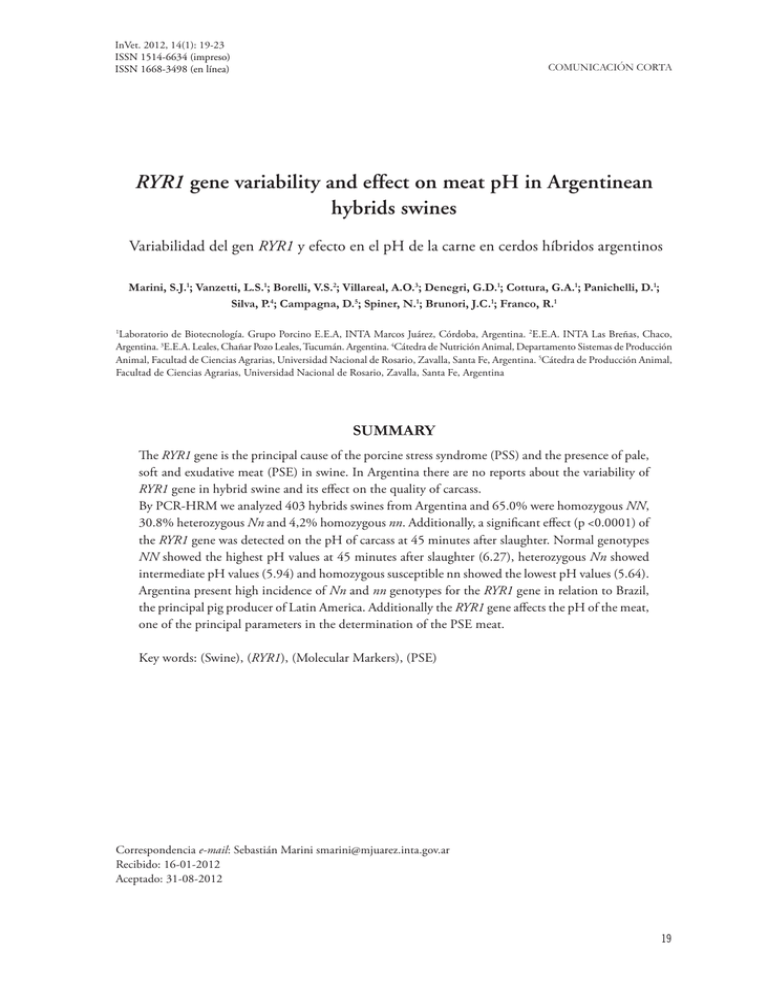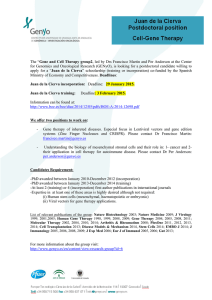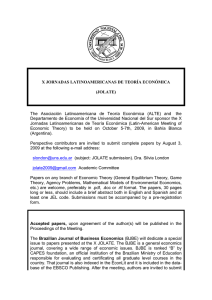RYR1 gene variability and effect on meat pH in Argentinean hybrids
Anuncio

InVet. 2012, 14(1): 19-23 ISSN 1514-6634 (impreso) ISSN 1668-3498 (en línea) RYR1 variability in Argentinean swines COMUNICACIÓN CORTA RYR1 gene variability and effect on meat pH in Argentinean hybrids swines Variabilidad del gen RYR1 y efecto en el pH de la carne en cerdos híbridos argentinos Marini, S.J.1; Vanzetti, L.S.1; Borelli, V.S.2; Villareal, A.O.3; Denegri, G.D.1; Cottura, G.A.1; Panichelli, D.1; Silva, P.4; Campagna, D.5; Spiner, N.1; Brunori, J.C.1; Franco, R.1 Laboratorio de Biotecnología. Grupo Porcino E.E.A, INTA Marcos Juárez, Córdoba, Argentina. 2E.E.A. INTA Las Breñas, Chaco, Argentina. 3E.E.A. Leales, Chañar Pozo Leales, Tucumán. Argentina. 4Cátedra de Nutrición Animal, Departamento Sistemas de Producción Animal, Facultad de Ciencias Agrarias, Universidad Nacional de Rosario, Zavalla, Santa Fe, Argentina. 5Cátedra de Producción Animal, Facultad de Ciencias Agrarias, Universidad Nacional de Rosario, Zavalla, Santa Fe, Argentina 1 Summary The RYR1 gene is the principal cause of the porcine stress syndrome (PSS) and the presence of pale, soft and exudative meat (PSE) in swine. In Argentina there are no reports about the variability of RYR1 gene in hybrid swine and its effect on the quality of carcass. By PCR-HRM we analyzed 403 hybrids swines from Argentina and 65.0% were homozygous NN, 30.8% heterozygous Nn and 4,2% homozygous nn. Additionally, a significant effect (p <0.0001) of the RYR1 gene was detected on the pH of carcass at 45 minutes after slaughter. Normal genotypes NN showed the highest pH values at 45 minutes after slaughter (6.27), heterozygous Nn showed intermediate pH values (5.94) and homozygous susceptible nn showed the lowest pH values (5.64). Argentina present high incidence of Nn and nn genotypes for the RYR1 gene in relation to Brazil, the principal pig producer of Latin America. Additionally the RYR1 gene affects the pH of the meat, one of the principal parameters in the determination of the PSE meat. Key words: (Swine), (RYR1), (Molecular Markers), (PSE) Correspondencia e-mail: Sebastián Marini smarini@mjuarez.inta.gov.ar Recibido: 16-01-2012 Aceptado: 31-08-2012 InVet Vol. 14 Nº 1, 2012 19 Marini, S.J.; Vanzetti, L.S.; Borelli, V.S.; Villareal, A.O.; Denegri, G.D.; Cottura, G.A.; Panichelli, D.; Silva, P.; Campagna, D.; Spiner, N.; Brunori, J.C.; Franco, R. RESUMEN El gen RYR1 es la principal causa del síndrome de estrés porcino (PSS) y la presencia de carne pálida, blanda y exudativa (PSE) en los cerdos. En Argentina no existen informes sobre la variabilidad de dicho gen en cerdos híbridos y su efecto sobre la calidad de la canal. Por PCR-HRM se analizaron 403 cerdos híbridos de Argentina y el 65,0% eran homocigotos NN, 30.8% heterocigotos Nn y el 4,2% homocigotos nn. Además, se detectó un efecto significativo (p <0,0001) del gen RYR1 en el pH de la canal a los 45 minutos post faena. Los genotipos NN mostraron los mayores valores de pH a los 45 minutos después del sacrificio (6.27), los heterocigotos Nn mostraron valores intermedios de pH (5,94) y los homocigotos nn presentaron los valores más bajos de pH (5,64). Argentina presenta alta incidencia de los genotipos Nn y nn del gen RYR1 en relación a Brasil, el principal productor de cerdos de América Latina. Además, el gen RYR1 afecta al pH de la carne, uno de los principales parámetros para la determinación de carnes PSE. Palabras clave: (Cerdos), (RYR1), (Marcadores moleculares), (PSE) Introduction In recent years, pig production sector, worldwide has endeavored to select lean hogs. However, from the sixties, it was observed that the selection results were linked to high mortality due to stress. The selection of breeding with better lean features and increased muscle development (breeds Pietrain, Poland China and Landrace) corresponded with diseased animals or bearer of the Porcine Stress Syndrome (PSS) or malignant hyperthermia (MH). Sick animals, with the minimum stress can show clinical signs such as tremors and muscle stiffness, purplish spots on skin, increased body temperature and may even lead to death, causing significant losses in primary production5. After sacrificing the animal, this disease compromises pork quality due to the rapid decrease in pH, resulting in a pale, soft and exudative meat (PSE). These results in great losses in the industry at obtain a product with altered colors and flavors and lower yield in the cooking. The main cause of this disease is a mutation at nucleotide 1843 of cDNA (GenBank M911451) of the gene encoding the calcium release channel in the 20 skeletal muscle sarcoplasmic reticulum called ryanodine receptor (RYR1), commonly known as the halothane gene (HAL)7. High-Resolution Melting (HMR) is a post PCR analysis method used to identify genetic variations in nucleic acid sequences. This method is based on the properties of dissociation (melting) of double-stranded DNA. Different melting profiles are obtained from the transition of double-stranded DNA to simple-stranded DNA due to a gradual increase in temperature after the PCR10. The recent development of HRM can be attributed to the generation of new dyes designed for this technique, and technological improvements in the instruments of real-time PCR13, 8. HRM is considered the simplest method for genotyping and mutation detection because it is done in the same tube and immediately after the PCR9, 10, 12. In Argentina there is no precedent in the incidence of RYR1 gene and its effect on the quality of carcass, therefore the objective of this study was to evaluate the variability of this gene and the effect in the pH of the carcass of hybrids pigs from four provinces of Argentina which represents the 60% of pig production in Argentina. InVet Vol. 14 Nº 1, 2012 RYR1 variability in Argentinean swines MATERIALS AND METHODS RESULTS For the analysis 403 commercial hybrid pigs were used. The animals come 20 different producers from 4 different states of Argentina (Córdoba, Santa Fe, Chaco and Tucumán). The main of the tested animals are hybrids derived from crossing hybrids females Landrace x Yorkshire with terminal hybrids males composed by different proportions of Duroc, Pietrain, Hampshire and Yorkshire, the tested animals were unrelated in parentage within producers. The pigs were slaughtered at a live weight between 100 and 110 kg and were deprived of food for around 18 hs before slaughter, but had access to fresh water ad libitum. The pigs were electrically stunned and bled by puncture in the jugular vein. The pH of carcass was measured in the longissimus dorsi muscle between the ribs 9 and 11 at 45 min postmortem in the left half of the carcass with a digital pH meter (Testo 205). Genomic DNA was extracted from hair roots using the protocol detailed in Bastos et al. (2000)2. The amplification of PCR products was made using the cycling conditions and primers developed by Brenig and Brem (1992)4 in a final volume of 25 µl which contained 1X Real Mix (Biodynamics), 0,2 µM of each primer, 5 µl of extraction solution of genomic DNA and mQ H2O. The C/T single nucleotide polymorphism (SNP) in the RYR1 was detected using High Resolution Melting (HRM) using a Thermal Cycler Rotor Gene Real Time Q (Qiagen). HRM consisted of a temperature ramp between 83 and 89 °C, rising by 0.1 °C⁄ 2 s. The SNPs detection by HRM is faster than the commonly used PCR-RFLP technique due the elimination of the restriction enzyme and the electrophoresis. The allelic and genotypic frequencies and analyses of variance were performed using the program Infostat6. Least squares means were compared using the Fisher’s LSD test with a comparison error rate of 0.05. Of the 403 pigs used for this study, 19.6% had the allele “n” associated with susceptibility to porcine stress syndrome (PSS), while 80.4% had the allele “N” normal or resistant to PSS. Genotypic frequencies observed were 65.0% homozygous normal or resistant individuals (NN) to the PSS, 30.8% of individuals heterozygous (Nn) and 4.2% homozygous susceptible (nn) at PSS (Table 2, Fig 1). Additionally, we observed a highly significant effect (p <0.0001) of the RYR1 gene on meat pH at 45 min. post slaughter, which is the main parameter used to determine type PSE meat. Individuals homozygous normal (NN) showed the higher values of pH (6.27), individuals heterozygous (Nn) had intermediate values of pH (5.94) and individuals homozygous recessive (nn) showed the lowest values of pH (5.64) (Table 1). DISCUSSION When we compare the frequencies observed in this work and the observed in another works from Brazil1,3,11 (the principal pig-producer of Latin America), we observe higher incidence of Nn and nn genotypes (Table 2). The probable causes of this situation may be due to the lack of knowledge about the allele constitution by the breeders, the use of different pure lines in the formation of hybrids and the lack of planning of crosses made. The molecular marker assisted selection is an interesting tool that can help to reduce the frequencies of nn genotypes as well as the presence of PSE meat in Argentinean hybrid pig populations. This will allow to Argentina to be a producer of pork with good quality. Additionally the DNA extraction from plucked hairs and detection of the RYR1 C/T polymorphism by HRM are interesting approaches to extend the detection of this SNP to producers and breeding companies in order to reduce the high frequency of susceptible allele (n) in Argentinean swines. InVet Vol. 14 Nº 1, 2012 21 Marini, S.J.; Vanzetti, L.S.; Borelli, V.S.; Villareal, A.O.; Denegri, G.D.; Cottura, G.A.; Panichelli, D.; Silva, P.; Campagna, D.; Spiner, N.; Brunori, J.C.; Franco, R. Figure 1. High-resolution melting profile showing the resolved RYR1 genotypes. Homozygous NN (green line), heterozygous Nn (blue line) and homozygous nn (red line). a: Melting curves, b: Normalized melting profile and c: Fluorescence difference plot Table 1. pH of meat in different RYR1 genotypes RYR1 Genotypes pH n NN 6.27±0.58 A 262 Nn 5.94±0.46 B 124 nn 5.64±0.32 C Means with different letters are significantly differentat p<0.05 17 Table 2. Allelic and genotypic frequencies (%) of RYR1 gene in Angentina and Brazil Argentina Bastos et al. (2001)3 Band et al. (2005)1 Silveira et al. (2011)11 n % n % n % n % n % NN 262 65.0 84 52.6 493 82.6 46 40.0 623 71.4 Nn 124 30.8 67 41.8 103 17.2 69 60.0 239 27.5 nn 17 4.2 9 5.6 1 0.2 0 0.0 10 1.1 Genotypic frequencies Brazil (average) Allelic frequencies 22 n 19.6 26.9 8.8 30.0 14.9 N 80.4 73.1 91.2 70.0 85.1 InVet Vol. 14 Nº 1, 2012 RYR1 variability in Argentinean swines REFERENCES 1.Band, G.O.; Guimarães, S.E.F.; Lopes, P.S.; et al. Relationship between the Porcine Stress Syndrome gene and pork quality traits of F2 pigs resulting from divergent crosses. Genet Mol Biol. 2055; 28(1):88-89. 2.Bastos, R.G.; Federizzi, J.; Deschamps, J.C.; Cardellino, R.A. and Dellagostin,O.A. Characterization of swine stress gene by DNA testing using plucked hair as a source of DNA. Genet Mol Biol. 2000; 23(4):815-817. 3.Bastos, R.G.; Federizzi, J.; Deschamps, J.C.; Cardellino, R.A. and Dellagostin, O.A. Efeito do Gene do Estresse Suíno sobre Características de Quantidade e Qualidade de Carcaça. Rev Bras Zootec. 2001;30(1):37-40. 4.Brenig, B. and Brem, G. Genomic organization and analysis of the 5´end of the porcine ryanodine receptor gene (RYR1). FEBS Lett. 1992; 298(2,3):277-279. 5.Bonelli, A. M. and Schifferli, R.C. Porcine Stress Syndrome. Arch Med Vet. 2001; 33(2):125-135. 6.Di Rienzo, J.A.; Casanoves, F.; Balzarini, M.G.; Gonzalez, L.; Tablada, M. and Robledo, C.W. InfoStat versión 2011. Grupo InfoStat, FCA, Universidad Nacional de Córdoba, Argentina. http://www.infostat. com.ar 8.Herrmann, M.G.; Durtschi, J.D.; Wittwer, C.T. and Voelkerding, K.V. Expanded instrument comparison of amplicon DNA melting analysis for mutation scanning and genotyping. Clin Chem. 2007; 53:1544–1548. 9.Montgomery, J.; Wittwer, C.T.; Palais, R. and Zhou, L. Simultaneous mutation scanning and genotyping by high-resolution DNA melting analysis. Nat Protoc. 2007; 2(1):59–66. 10. Reed, G.H.; Kent, J.O. and Wittwer, C.T. Highresolution DNA melting analysis for simple and efficient molecular diagnostics. Pharmacogenomics. 2007; 8(6):597–608. 11. Silveira, A.C.P.; Freitas, P.F.A.; Cesar, A.S.M. and et al. Influence of the halothane gene (HAL) on pork quality in two commercial crossbreeds. Genet Mol Res. 2011; 10(3):1479-1489. 12. Vossen, R.H.A.M.; Aten, E.; Roos, A. and den Dunnen, J.T. High-resolution melting analysis (HRMA)-more than just sequence variant screening. Hum Mutat. 2009; 30(6): 860–866. 13. Wittwer, C.T.; Reed, G.H.; Gundry, C.N.; Vandersteen, J.G. and Pryor, R.J. High-resolution genotyping by amplicon melting analysis using LC Green. Clin Chem. 2033; 49:853–860. 7.Fujii, J.; Otsu, K.; Zorzato, F.; et al. Identification of mutation in porcine ryanodine receptor associated with malignant hiperthermia. Science. 1991; 253(5018):448-451. InVet Vol. 14 Nº 1, 2012 23






